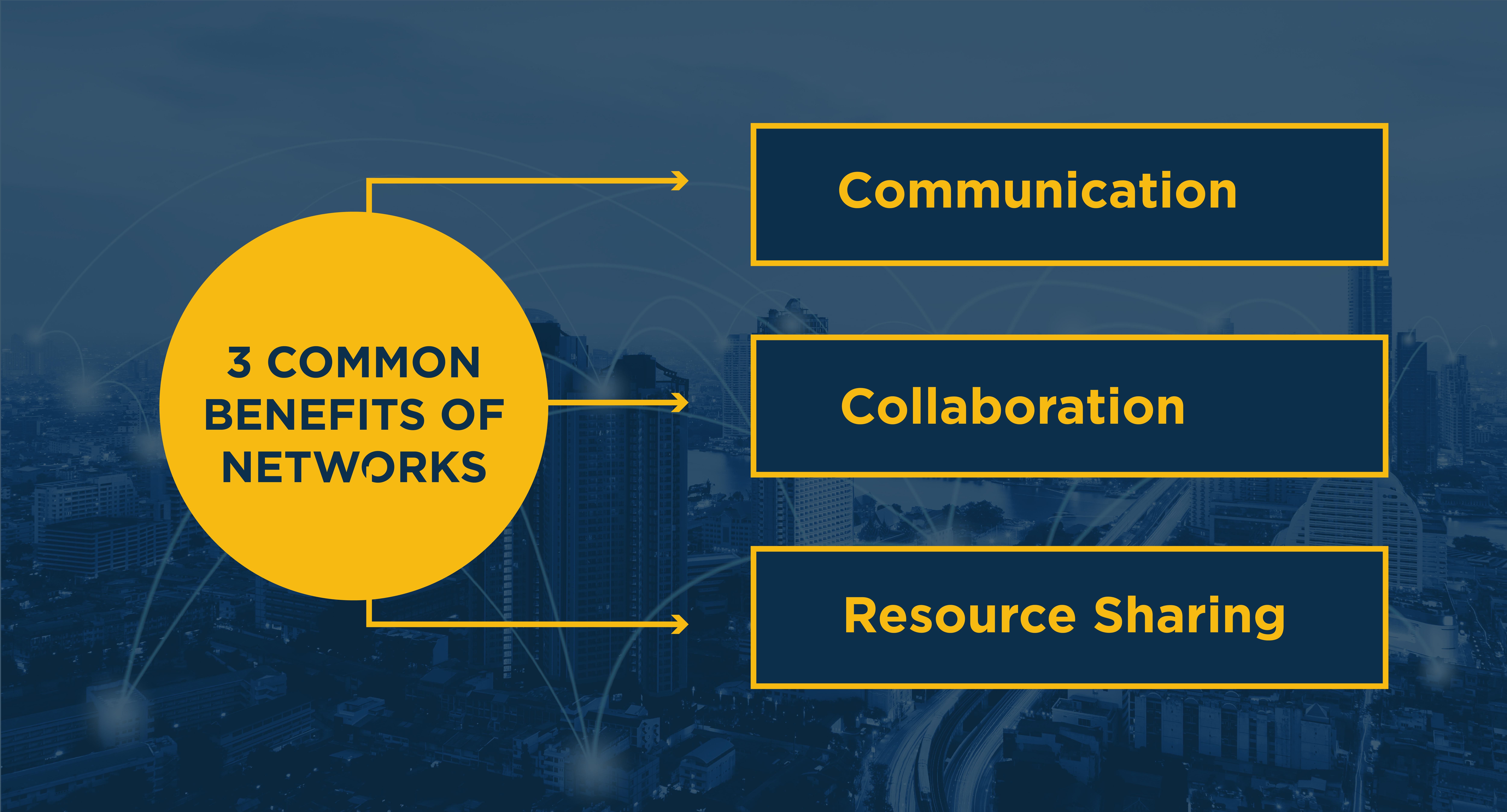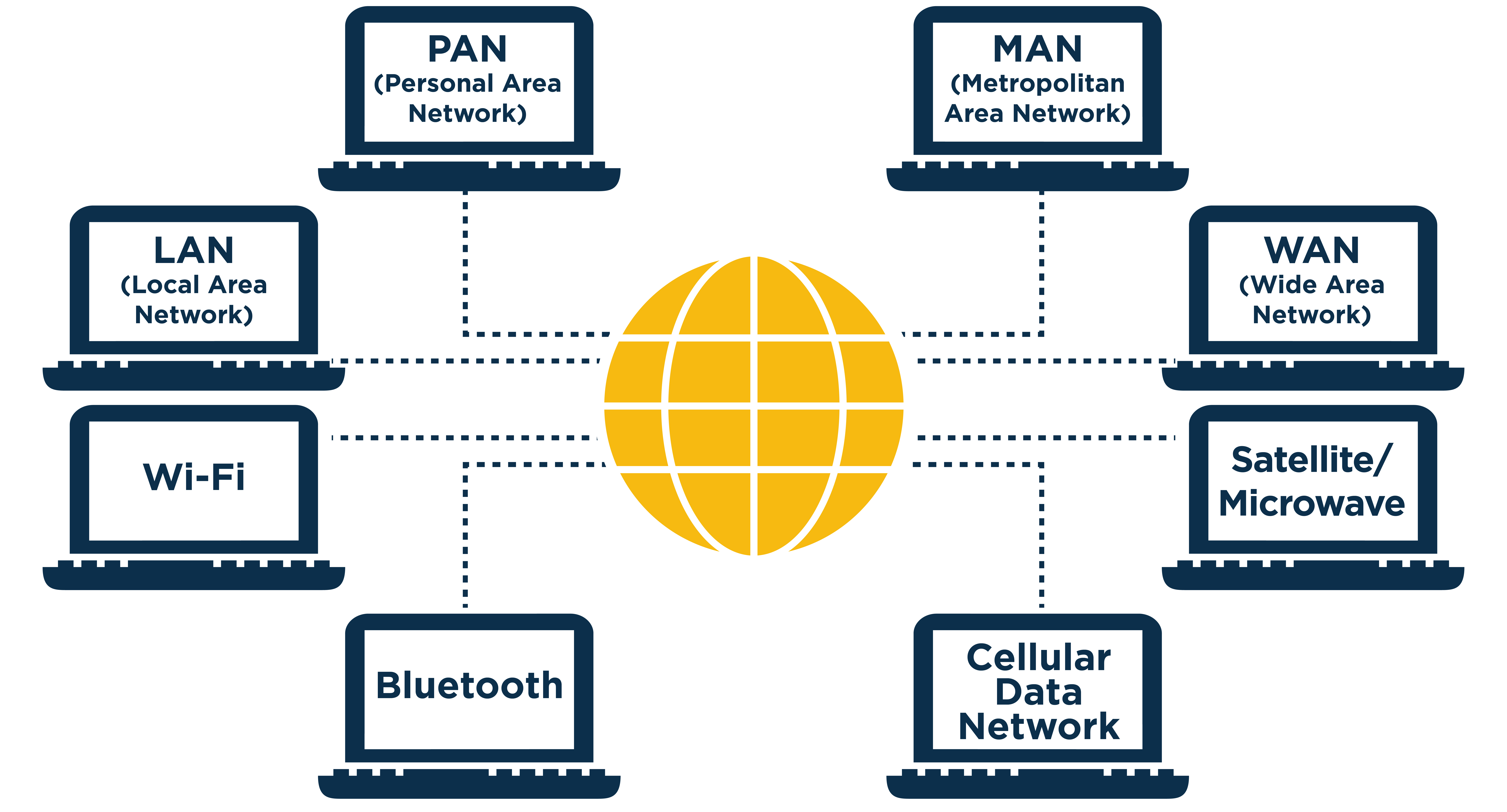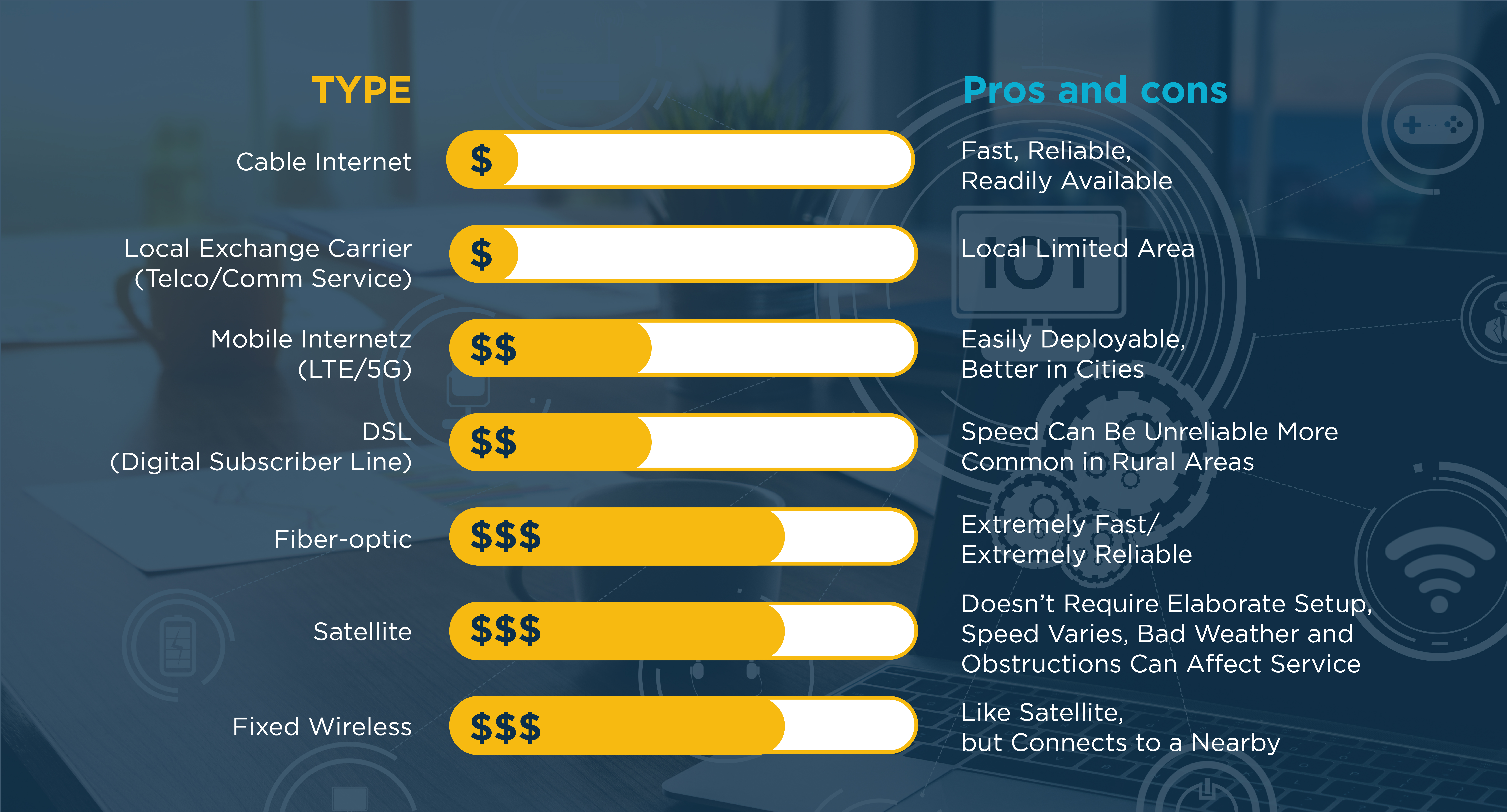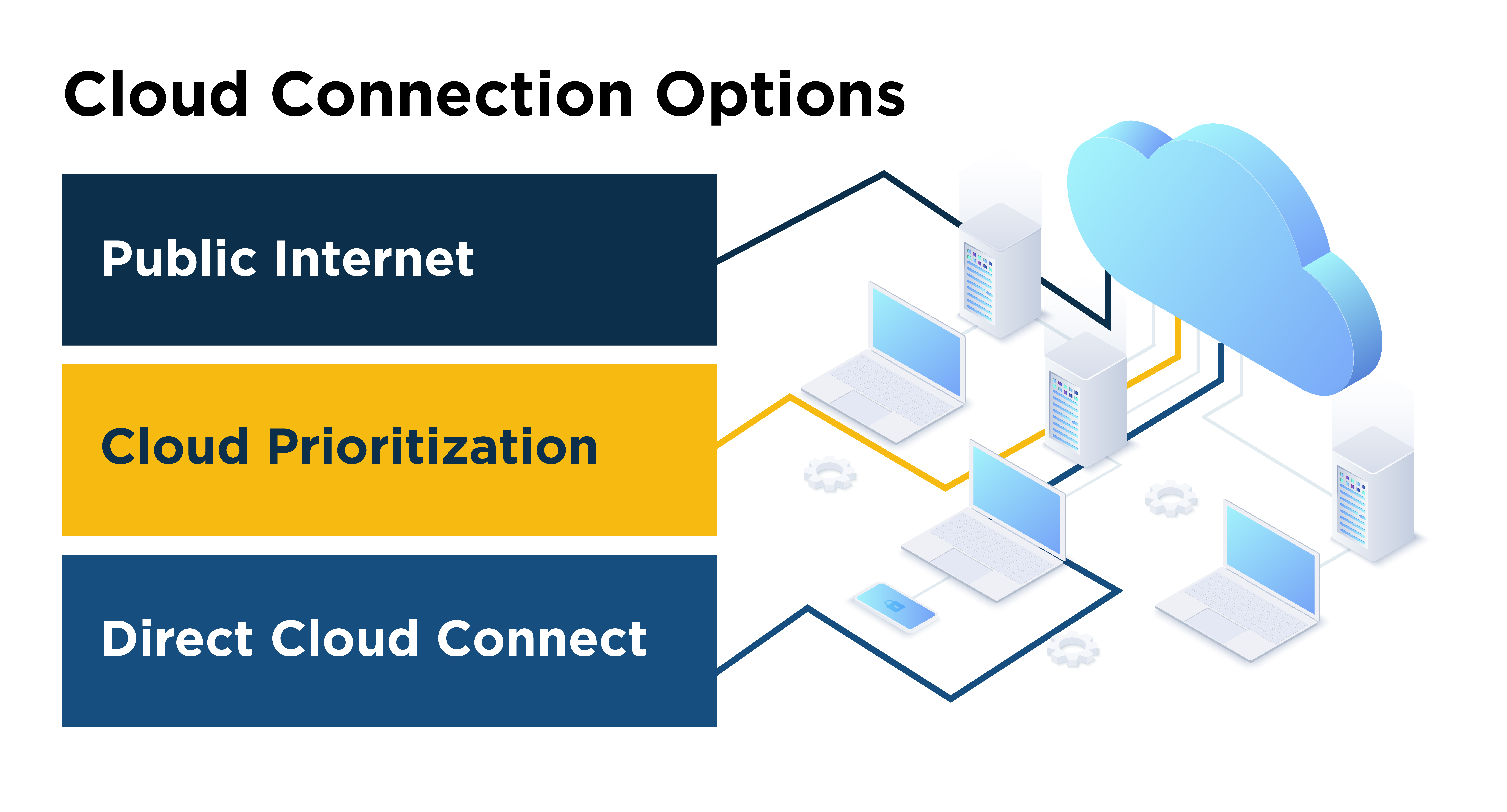Network and Voice Data
A network is any system that transfers information (data) between two or more points. This includes the things you see, such as phones, computers, applications (e.g. Microsoft Teams, Salesforce), Point of Sales (POS) systems, security cameras, computer cables, servers, and signage. It also includes the things you don’t see, such as switches, data packets, redundancy, failover, cybersecurity, backup, and Access Points (APs). These systems can be digital from end-to-end or have analog components that tie in via an appliance. Data can be simplex (flowing in one direction) or duplex (flowing back and forth). For common applications and extended functionality, become familiar with the broad category of Mobility, Wireless, Alternative Access, Internet of Things (IoT), and Artificial Intelligence/Machine Learning (AI/ML).
Network and Voice Data Integration
What began as a fundamental change in the telecommunications and data industries is now the norm. Voice Providers offer data, and data Providers, offer voice. Data networking and telecommunications are, in essence, one industry and a single community. Organizations and individuals are the winners with better phone service, lower prices, new features, less maintenance, and increased choice. To investigate this further, get up-to-speed on UCaaS (Unified Communications as a Service), CCaaS (Contact Center as a Services), Cloud, and SD-WAN solutions.
Integrity, Speed, and Capacity
Every company is in the business of data. It’s a big world, but in the digital age, and within seconds, we can touch any part of it. Data opens huge possibilies but can also effect the frailty of the network, leading to quick and huge repercussions. Information needs to remain secure and accessible, whether it’s a customer’s buying history or proprietary information like a pharmaceutical production process. Lag to access information can stall operations meaning lost productivity or opportunity. As the capital of information grows, and it is an economically measurable asset, organizations need to be able to collect and work with the data without limitation.

Communication – fast, seamless interactions between one or more individuals or entities. This can be anything from a direct customer service phone call/Video chat/text/SMS message or a transfer of files without physical media.
Collaboration – anywhere in the world multiple users can simultaneously work together, or pass projects across time zones to maintain a productive workflow 24 hours a day, 7 days a week.
Resource Sharing – efficiencies are unlocked, from simple items like sharing printers and storage, right through to cost saving allocation of resources including intelligent call routing or SD-WAN systems that prioritize and regulate optimal data flow.
2 Basic Types of Data Networks
Private Data Networks are designed to facilitate data transmission between individuals and departments within a single organization, even if they are located in different geographical locations. The network can be designed to encompass facilities as nodes on the network to allow communication and data transfer via a centralized server or server facility. Private data networks can be created by provisioning the connections through a communications carrier or using VPNs (virtual private networks).
Public Data Networks, as the name implies, isn’t limited to users and systems within a single organization. It can be accessed by individual and corporate entities practically anywhere. A public network is set up using multiple servers, communication protocols, and cell towers to transmit data over distances.
Additional Network Classifications
Data networks can also be classified based on size, physical architecture, and coverage area.

PAN (Personal Area Network) is a network designed to connect computers and devices within a user’s personal workspace.
LAN (Local Area Network) is a type of data network that uses switches, routers, cables, and access points to enable the interconnection of devices and endpoints to internal/web servers within a limited area (such as a building or an office).
Wi-Fi is a wireless LAN standard, used for communication among devices on a small scale. Wi-Fi can be one of the cheapest and fastest ways for short-distance transmission enabling regular activities like video streaming, VoIP, online gaming, and web browsing. Several Wi-Fi standards have been developed and certified by the Wi-Fi Alliance including 802.11a, 802.11b, 802.11g, 802.11n, 802.11ac, and 802.11ax. Wi-Fi uses radio frequencies between devices, 2.4 GHz provides great coverage but slower speeds, while 5GHz has faster data rates over a smaller area. Wi-Fi devices need to have an initial connection (often wired via DSL, cable, or fiber, or via a mobile hotspot) unless they’re part of a mesh system that works together to extend coverage. The current Wi-Fi security standard is WPA2 or WPA3.
Bluetooth is a short-range wireless technology that allows devices to transmit data or voice over a short distance, eliminating cables and providing a convenient connection standard. Most Bluetooth devices have a maximum connectivity range of 30 feet, although that distance can be reduced if an obstacle, like a wall, is in the way. This technology is generally secure and safe because they operate across frequencies, hopping hundreds of times each second.
MAN (Metropolitan Area Network) is designed and works essentially like a LAN — but it covers a much larger area. A MAN can be designed to span several buildings and typically covers a metropolitan area or campus.
WAN (Wide Area Network) is a collection of LANs and other data networks that share information and communicate with each other over a large area (typically 50 kilometers or more in diameter). The internet is the largest example of a WAN. It relies on a large, complex network of service providers using servers, modems, switches, and routers to provide connectivity to organizations and individuals all around the world.
Satellite/Microwave network comprises one central hub and thousands of remote hubs designed to transmit everything from weather data, voice, and data to mobile devices, television, telecommunications, radio, navigation information, military surveillance, and broadband internet service. A signal can be bounced off a satellite in the atmosphere or be terrestrial, but both require a line of sight for the technology to work.
Cellular Data Network is a wireless network, often referred to as Mobility, where fixed-location transceiver base stations (distributed over land cells) provide each cell point with network coverage to enable it to transmit content such as data and voice. Each cell is designated with a unique frequency (or set of frequencies) to avoid communication interference with other nearby cells.
Connectivity: Pros, Cons and Cost
There have never been more choices for connecting to your network. Some are new and innovative, while others date back many centuries. This conversation is not about what is best overall, but rather, what is the best application in a given situation. Additionally, no one solution is foolproof, having multiple connections in place and the management systems to prioritize/direct activity can increase productivity and elevate user experiences.

Network Infrastructure and Solutions
Cloud provides flexibility and scalability for both the technology solutions organizations require and the IT departments that needs to support them – Cloud is the way to have it all, reliability, security, affordability, and predictable costs.
Physical local-based hardware can include everything from cabling to appliances like switches, routers, legacy devices, and computers (which can also be delivered HaaS – Hardware as a Service – simplifying the deployment, management, maintenance, and eventual retirement)
Hybrid Environments blend the physical with the Cloud, providing several advantages. They allow organizations to take advantage of existing infrastructure, employ specific technology that may be specific to a task/industry, or meet criteria that can only be solved by an on-prem solution. Again, organizations can own elements outright, or work with a Provider who oversees the technology performance and maintenance.
On-Premise Datacenter is where an organization places its hardware (servers, and other network equipment) in its operating center, building, or campus. More and more organizations are moving away from on-prem approaches as they adopt agile operational expenditure strategies that encourage innovation, competition, and growth over upfront heavy capital expenditures (owning infrastructure) approaches.
Colocation Datacenter, often referred to as Colo’s are large data center facilities that rent out rack space to third parties for their servers or other network equipment. This is similar to Cloud deployment, but the third party, or the end-user organization, owns the equipment outright, often spreading equipment over several locations to ensure stability.
Edge Computing is an approach that brings computation (processing/analyzing) and data storage closer to where it is generated to eliminate latency, save bandwidth, and reduce network costs.
Software Defined (SD-WAN/SASE-Secure Access Service Edge) solutions and services allow organizations moving to the Cloud to optimize their unique usage and other requirements – from intelligent routing across campus, city, states, and the globe to ensuring the highest level of performance (including load balancing and operational prioritization) and protection against internal and external threats. This solution helps centralize the IT department, or Managed Services Partner, giving full functional control over the network, its performance, and user experience.
Third-Party Applications and Collaboration Platforms (e.g. Microsoft Teams, Adobe Creative Cloud, Amazon Web Services, Slack, Salesforce) that organizations thrive on, are all being delivered via the Cloud.
Storage and Backup are not the same things. Storage is where you deposit files you need to be accessible – data that you will be actively working with. Backup is ensuring that you have this data and will be able to read it in the weeks, months, or years that follow. It also provides a copy if anything happens to the original. The act of backing up should be conducted with a predetermined schedule and routine and to a safe place. If a fire, flood, or earthquake happened you would lose everything. Additionally, if you fall victim to a cyberattack, you would be able to restore operations from your backup.
Managed Services is simply delegating IT operations to a third-party, often referred to as an MSP (Managed Service Provider). Organizations are increasingly moving in this direction as IT requirements become more involved/changing, expertise is harder to attain, and the need for flexibility increases. Organizations can choose to contract their entire IT operations, or selectively offer certain services, including:

Cybersecurity is a very specialized subset of information technology and one that is increasingly taking the spotlight as attacks grow – both in complexity and intensity. The cost both monetarily and reputationally is something that should be taken seriously. A large percentage of companies who face a cyberattack are unable to recover, and cease operations within 6 months of the attack.
Network and Data Recovery should always be a part of your strategy – encompassing the policies, tools, and procedures necessary to continue or recover infrastructure following a natural or human-induced disaster. DRaaS (Disaster Recovery as a Service) is a Cloud-based service that can simplify and ensure your organization is covered.

Public Internet. The most obvious way to connect to the Cloud is via the public internet. While cost-effective and readily available, it can have limitations for security, latency rates, consistent throughput, and reliability – all the things that most organizations are not willing to sacrifice. This option is often called IP access or IP transit.
Cloud Prioritization dynamically reserves a portion of normal internet bandwidth for select Cloud applications, both incoming and outgoing. Certified network service providers offer this direct peering with Cloud providers to enable end-users with direct access to the Cloud services. An example of this would be the Microsoft Azure Peering Services (MAPS).
Direct Cloud Connect is the fastest and safest method for Cloud connectivity, with a dedicated ethernet internet-bypass solution. It is the result of Amazon, Microsoft, Google, Oracle, and IBM working together with network service providers to enhance end-to-end Cloud connectivity and automation capabilities without touching the internet. Examples of this approach include AWS Direct Connect, Microsoft ExpressRoute, and Google Cloud Interconnect.
Cloud connect doesn’t require huge resources or a large corporate network. Organizations can integrate Cloud connectivity into an IP-VPN (or MPLS-WAN) or through SD-WAN (SD-WAN Cloud Access/SD-WAN Multi-cloud) approaches.
Network Optimization and QoS (Quality of Service)
The start and end of every network conversation should be about performance and limitations. Are certain elements, like Microsoft Teams running slowly? Do calls drop out or is voice quality below where you’d like it to be? Are more seats being paid for than used? Each challenge can be approached in different ways – from providing more bandwidth overall to prioritizing some activities over others (e.g. Salesforce over Facebook, or voice-over video) to active admin systems that regulate usage and empower users.
Watch the Connectivity webinar on demand, hosted by Gerry Davis, SVP Sales Engineering and Andrew Rustad, Director, Sales Engineer East to learn more about this interesting category, and ways to introduce and sell solutions to your customers.

Our team is always here to help you expand your Data, Voice, and Network business!
Our Featured Providers
Comcast Business is one of the nation’s largest Providers of video, high-speed Internet, voice, phone and enterprise solutions to residential and business customers. Comcast also provides a suite of Managed and Professional Services that reduce the complexity of enterprise networks while increasing performance by targeting key metrics like bandwidth, uptime, QoS and incident response times allowing organizations additional opportunities to innovate.
Colt is a global network connectivity and Cloud computing Provider spanning over 210 cities in more than 30 countries across Europe, Asia and North America, with over 29,000 on-net buildings and counting. Colt is an innovator in Software Defined Networks (SDN) and Network Function Virtualization (NFV) services, and connects over 900 datacenters worldwide.
Granite is a leading service provider for multi-location businesses in the US and Canada. Granite brings stability to both end-users and partners, helping more than 2/3rds of the Fortune 100 with their voice and data requirements. Granite’s core products include POTS, Epik (wireless POTS replacement), SIP, 7 different SD-WAN platform, Mobility and IoT, Managed Services (SD-WAN, switches, firewalls, AP’s, circuits).
Zayo provides Communications Infrastructure services, including fiber and bandwidth Connectivity, Colocation and Cloud services. Zayo’s 127,000-mile network in North America and Europe, includes extensive metro connectivity to thousands of buildings and data centers. In addition to high-capacity dark fiber, wavelength, Ethernet and other connectivity solutions, Zayo offers Colocation and Cloud infrastructure in its carrier-neutral data centers.
Sandler Partners have access to the full portfolio of 106+ Data, Voice and Network solution Providers — including leading providers DYOPATH, EpicIO, Fusion Connect, Nexogy, Ooma, PhoenixNAP, TPx, Verizon, Vonage, Windstream, WiredIQ, and Zultys. You can review all your available options by using the Solutions Finder or Solutions Index tools located in the Sandler Portal. For help navigating your way through the process, while discovering the best provider(s) solutions available to meet your client’s requirements, simply contact our Sales Engineering Team!
